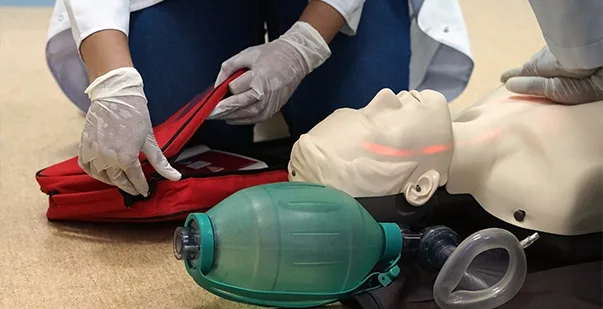Basic life support is a crucial skill that every healthcare provider must know. The online bls training involves learning life-saving skills such as performing cardiopulmonary resuscitation, maintaining circulation, and learning ways to use an automated external defibrillator. The key numbers of BLS are important during emergencies for the best results.
Want to know the BLS numbers to apply in real-life emergencies? Keep reading this blog to master them and get started.
Master BLS Now
Get BLS certified with confidence
What are the key components of effective BLS interventions?
Effective BLS interventions help to increase the chances of survival in emergencies. BLS focuses on maintaining airways and ensuring effective circulation. Here are crucial components of BLS interventions:
Airway Management:
Keeping the airway open is the first priority in BLS. Techniques like the head-tilt and chin-lift maneuver are used to clear the airway and ensure proper airflow.
Effective Chest Compressions:
Delivering high-quality chest compressions at the correct rate (100-120 compressions per minute) and depth (at least 2 inches for adults) ensures circulation of oxygen-rich blood.
Rescue Breathing:
Rescue breaths are vital for providing oxygen to the lungs. The 30:2 ratio of compressions to breaths helps maintain oxygenation alongside circulation.
Use of AED:
An Automated External Defibrillator (AED) should be used as soon as it is available, as it can analyze heart rhythms and deliver a shock if needed to restore normal cardiac function.
Minimizing Interruptions:
Continuous compressions with minimal interruptions are critical for maintaining blood flow. Pausing should only occur briefly to provide rescue breaths or use an AED.
What are the BLS numbers that you need to know?
BLS involves a series of steps crucial during medical emergencies. Know the key numbers to increase the chances of survival. Here are the BLS numbers that you must know.
The Optimal Chest Compression Rate: 100-120 Compressions Per Minute
When performing CPR, delivering chest compressions at a rate of 100 to 120 compressions per minute is critical for effective blood flow. This speed ensures that enough oxygen-rich blood reaches vital organs, especially the brain.
Compressions should be fast enough to maintain circulation but not too fast, as that can reduce the depth and effectiveness. Keeping the right pace can significantly improve the patient’s chances of survival during cardiac arrest.
Compression Depth Guidelines: 2 inches for adults, 1.5 inches for infants
The correct compression depth ensures that enough pressure is applied to the chest to help the heart pump blood.
For adults, compressions should be at least 2 inches deep to be effective. For infants, the depth should be approximately 1.5 inches to avoid injury while still generating adequate circulation. Applying the right amount of force tailored to the patient’s size is crucial for positive outcomes.
The 30:2 ratio: Compressions to Rescue Breaths in CPR
The 30:2 ratio refers to administering 30 chest compressions followed by 2 rescue breaths during CPR. This rhythm ensures oxygen is delivered to the lungs while maintaining circulation.
Rescue breaths are vital to providing oxygen, but compressions are prioritized to keep the blood moving. Consistently following this ratio can maximize the effectiveness of CPR in both adults and children.
AED Usage: When and How to Deliver a Shock
An Automated External Defibrillator (AED) is used when a person is in sudden cardiac arrest and the heart’s rhythm is irregular or has stopped. The device analyzes the heart rhythm and, if necessary, instructs the user to deliver a shock.
AEDs are designed for ease of use, even by non-medical personnel, and should be applied as soon as available. Quick use of an AED greatly increases the chance of survival, especially when combined with effective CPR.
Rescue Breath Timing: Every 5-6 Seconds for Adults
During CPR, rescue breaths are administered to provide oxygen to the lungs and bloodstream. For adults, one rescue breath should be given every 5-6 seconds, or about 10-12 breaths per minute.
Each breath should last about one second, with the chest visibly rising. Proper timing of rescue breaths is essential to avoid over ventilating and to ensure effective oxygenation.
Minimizing Interruptions: Why Continuous Compressions Matter
Continuous chest compressions are vital to maintaining blood flow during CPR, and interruptions should be minimized. Pausing too frequently or for too long can drastically reduce the chances of survival, as the heart needs constant pressure to keep pumping blood.
If pauses are necessary, they should be as brief as possible—such as when switching rescuers or using an AED. Maintaining compression continuity helps sustain oxygen delivery to the brain and other vital organs.
How to get BLS certified?
Becoming BLS certified is crucial for healthcare professionals. Here are steps to get BLS certified:
-
Find a Reputed Provider:
Look for reputed organizations offering BLS courses, either online or in person. These organizations offer trusted and widely recognized certifications. -
Register for the course:
Sign up for the course that fits your schedule. You can choose online options for convenience, followed by an in-person skills test, or opt for a classroom-based course. -
Complete the training:
Attend the course, which typically includes both theoretical instruction and hands-on practice of CPR, rescue breathing, and AED usage. -
Pass the Skills Test and Exam:
After completing the training, you’ll take a skills test to demonstrate your knowledge and proficiency, followed by a written exam if required. -
Receive Your Certification Card:
Upon successful completion, you’ll receive your BLS certification, often valid for two years. You can now confidently assist in emergencies.
Read more: A Simple Guide to Becoming a BLS Instructor
How long do you need to get BLS certified?
BLS certification is a simple course and does not take much time to complete. It takes around 4-5 hours, depending on the provider. Once you get certified, you must recertify after two years to keep practicing the key BLS skills.
Read more: Do You Need BLS If You Have ACLS
Conclusion
In Basic Life Support, it is crucial to know the right numbers to perform effective life-saving actions. Factors such as proper chest compression rate, depth, and ratio of compressions help provide high-quality CPR. These are essential guidelines that increase the chances of survival. So make sure you study the BLS numbers well to confidently respond during crucial moments.







